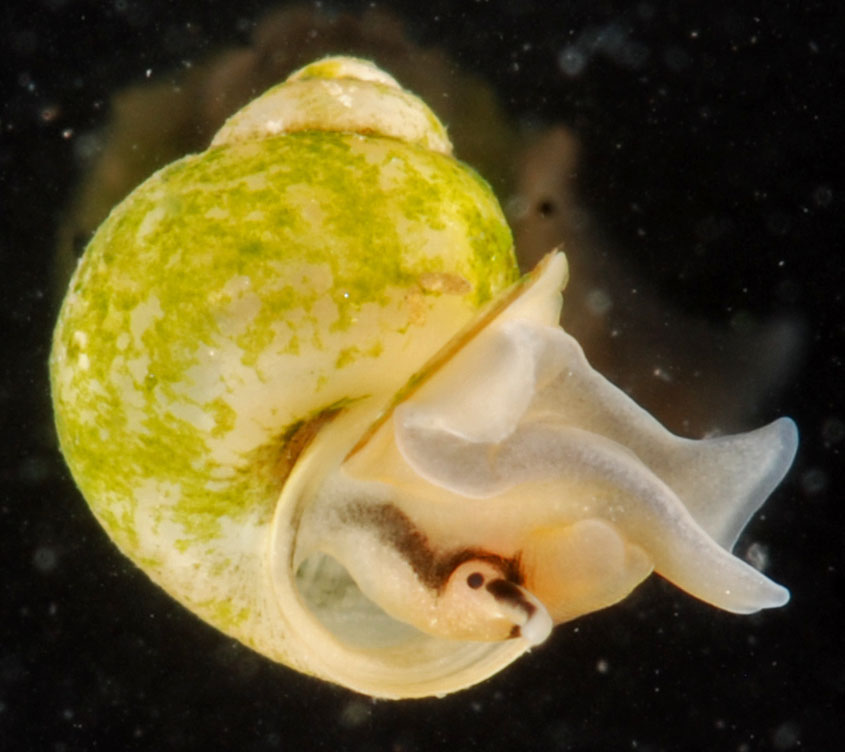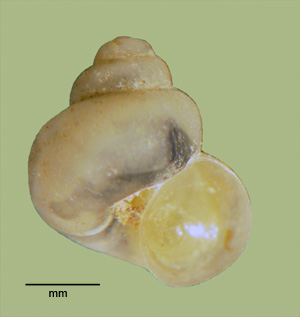> Habitat & Distribution
Amnicola limosa populations are widespread throughout most of North America, ranging north to the Hudson Bay, south to Florida, and as far west as Utah (Berry 1943, Clarke 1981). They are common in the lower piedmont and coastal plains of the Atlantic drainages across Georgia to the Gulf, and in drainages of The Ohio (proper), often associated with detritus or woody debris. Further north, Amnicola populations become quite common in ponds and lakes.
Populations are not typically found in waters of rapid flow, such as prevail in the Blue Ridge or Appalachian ecoregions, for example. They are rare in drainages of the Tennessee/Cumberland. They are also not found in waters that become hot, stagnant, or anaerobic. In the Great Plains, they are common in North Dakota, rare in South Dakota, and absent from Nebraska and Kansas. FWGNA incidence rank I-5.
> Ecology & Life History
Several excellent studies have been directed toward the biology of A. limosa populations inhabiting northern lakes and ponds. Amnicola populations appear to be efficient grazers of diatoms and other periphyton (Kesler 1981, Cattaneo & Kalff 1986). They in turn may be eaten by crayfish (Lewis 2001) and sunfish (Osenberg 1989, Bronmark et al 1992)
Populations generally appear to be annual and semelparous (cycle A of Dillon 2000: 156 162). But dynamics appear to be sensitive to aspects of water chemistry, especially hardness and pH (Shaw & Mackie 1989, 1990). Jokinen s (1987) analysis of the distribution of A. limosa in Connecticut and New York led her to classify it as a C-D tramp, potentially present in nearly every community. Dillon s (2000: 360-363) reanalysis of these data suggested that A. limosa populations in Connecticut seem to be Undifferentiated with respect to life history adaptation.
> Taxonomy & Systematics
The amnicoline penis, arising from the neck as is typical for rissooideans, is doubly-ducted (Hershler & Thompson 1988). Previous versions of this website followed Kabat & Hershler (1993) in recognizing the amnicolines as a subfamily in the large, inclusive Hydrobiidae (sl). More recent molecular phylogenetic evidence has suggested raising this group to the full family level, Amnicolidae (Wilke et al., 2013). See my essay of 18Aug16 from the link below.
Lower-level systematic relationships have remained relatively stable in the genus Amnicola (Berry 1943, Hershler & Thompson 1988), especially in comparison with most other hydrobioid taxa of North America. Of the two amnicolid genera inhabiting the southern Atlantic drainages, Amnicola (s.s.) is distinguished by its (entirely) paucispiral operculum. An A. limosa CO1 mtDNA sequence appeared among the outgroups in the molecular phylogenetic study of Liu and colleagues (2001).
> Supplementary Resources
- Amnicola distribution in drainages of The Ohio (2019)
- Amnicolid distribution in Atlantic drainages (2023)
- Amnicolid distribution in Georgia and the Florida panhandle (2025)
- Amnicola in the Tennessee/Cumberland (2022)
- Hydrobioid distribution in The Great Plains (2024)
- Living Amnicola limosa, courtesy of Rob Aguilar.

> Essays
- My post to the FWGNA blog of 26May04, Somatogyrus in the Southeast, also included notes on Amnicola and a nice comparative photo.
- See my post of 3Dec12, On Getting Clappia in Tennessee, for a photo comparing Amnicola to Somatogyrus, Clappia, and juvenile Leptoxis.
- Earlier versions of this website adopted the large, broadly-inclusive concept of the Hydrobiidae (sl) following Kabat & Hershler (1993). More recently the FWGNA project has shifted to the Wilke et al. (2013) classification system, distinguishing a much smaller Hydrobiidae (ss) and elevating many hydrobioid taxa previously ranked as subfamilies to the full family level. For more details, see my essay of 18Aug16, The Classification of the Hydrobioids.
> References
Berry, E. (1943) The Amnicolidae of Michigan: Distribution, ecology, and taxonomy. Misc. Publ. Mus. Zool. U. Mich., 57, 1-68.
Bronmark, C., Klosiewski, S. & Stein, R. (1992) Indirect effects of predation in a freshwater, benthic food chain. Ecology 73: 1662 1674.
Clarke, A. H. (1981) The Freshwater Molluscs of Canada. National Museums of Canada, Ottawa. 446 pp.
Dillon, R.T., Jr. (2000) The Ecology of Freshwater Molluscs. Cambridge University Press, Cambridge, United Kingdom. 509 pp.
Hershler, R. & Thompson, F.G. (1988) Notes on morphology of Amnicola limosa (Say, 1817) (Gastropoda: Hydrobiidae) with comments on status of the subfamily Amnicolinae. Malacol. Rev. 21: 81-92.
Horst, T.J. & Costa, R.R. (1975) Seasonal migration and density patterns of the fresh water snail Amnicola limosa. Nautilus 89: 56-59.
Jokinen, E. (1987) Structure of freshwater snail communities: Species-area relationships and incidence categories. Amer. Malac. Bull. 5: 9 - 19.
Kabat, A.R., and R. Hershler (1993) The prosobranch snail family Hydrobiidae (Gastropoda: Rissooidea): review of classification and supraspecific taxa. Smithsonian Contributions to Zoology 547:1-94.
Kesler, D.H. ( 1980) Seasonal abundance of Amnicola limosa (Hydrobiidae) eggs and individuals in a Rhode Island Pond. Nautilus 94: 25-26.
Kesler, D.H. (1981) Periphyton grazing by Amnicola limosa: An enclosure-exclosure experiment. J. Freshwat. Ecol. 1: 51-59. Kesler, D. H. & Tulou, C. A. G. (1980) Cellulase activity in the freshwater gastropod Amnicola limosa. Nautilus 94: 135-137.
Lewis, D. B. (2001) Trade-offs between growth and survival: Responses of freshwater snails to predacious crayfish. Ecology 82: 758-765.
Lewis, D. B. & Magnuson, J.J. (1999) Intraspecific gastropod shell strength variation among north temperate lakes. Can. J. Fish. Aquat. Sci. 56: 1687-1695.
Liu, H-P, Hershler, R. & Thompson, F. G. (2001) Phylogenetic relationships of the Cochliopinae (Rissooidea: Hydrobiidae): An enigmatic grop of aquatic gastropods. Molec. Phylog. Evol. 21: 17 -25.
Mackie, G.L. & Flippance, L.A. (1983) Relationships between buffering capacity of water and the size and calcium content of freshwater mollusks. Freshwat. Invertebr. Biol. 2: 48-55.
Osenberg, C. (1989) Resource limitation, competition and the influence of life history in a freshwater snail community. Oecologia 79: 512 519.
Pinel-Alloul, B. (1973) (Observations on the life cycle and growth of Amnicola limosa (Say) (Mollusca, Prosobranchia) from Lake St-Louis, Near Montreal). Can. J. Zool. 51: 311-313. Shaw, M. A. & Mackie, G.L. (1990) Effects of calcium and pH on the reproductive success of Amnicola limosa (Gastropoda). Can. J. Fish. Aquat. Sci. 47: 1694-1699.
Shaw, M.A. & Mackie, G.L. (1989) Reproductive success of Amnicola limosa (Gastropoda) in low alkalinity lakes in south-central Ontario. Can. J. Fish. Aquat. Sci. 46: 863-869. Molluscan Family Planorbidae. Urbana: University of Illinois Press.
Wilke T., Haase M., Hershler R., Liu H-P., Misof B., Ponder W. (2013) Pushing short DNA fragments to the limit: Phylogenetic relationships of hydrobioid gastropods (Caenogastropoda: Rissooidea). Molecular Phylogenetics and Evolution 66: 715 736.








